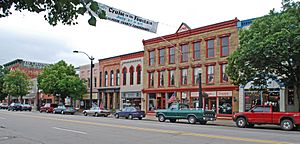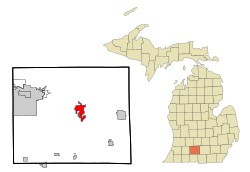Marshall, Michigan facts for kids
Quick facts for kids
Marshall, Michigan
|
|
|---|---|

Downtown Marshall
|
|

Location of Marshall, Michigan
|
|
| Country | United States |
| State | Michigan |
| County | Calhoun |
| Incorporated | 1836 (village) 1849 (city) |
| Area | |
| • Total | 6.61 sq mi (17.12 km2) |
| • Land | 6.49 sq mi (16.82 km2) |
| • Water | 0.12 sq mi (0.30 km2) |
| Elevation | 919 ft (280 m) |
| Population
(2020)
|
|
| • Total | 6,822 |
| • Density | 1,050.67/sq mi (405.66/km2) |
| Time zone | UTC-5 (Eastern (EST)) |
| • Summer (DST) | UTC-4 (EDT) |
| ZIP codes |
49068-49069
|
| Area code(s) | 269 |
| FIPS code | 26-51940 |
| GNIS feature ID | 631630 |
Marshall is a city in Michigan, United States. It is the main city of Calhoun County. In 2020, about 6,822 people lived there.
Marshall is famous for its old buildings. Many homes and businesses show styles from the 1800s and early 1900s. Experts call it a "textbook of 19th-Century American architecture." The Marshall Historic District is a very large area with over 850 important buildings. One famous building is the Honolulu House. Soon, Ford Motor Company will build a large battery factory here.
Contents
History of Marshall, Michigan
Marshall was started in 1830. It was named after John Marshall, a very important judge from Virginia. He was the Chief Justice of the United States. Marshall was one of the first places named after him.
People once thought Marshall would become the capital city of Michigan. A Governor's Mansion was even built there. But Marshall lost by just one vote to Lansing. For many years, Marshall was known for making special medicines. This ended when a new law, the Pure Drug Act of 1906, was passed.
Marshall played a big part in the Underground Railroad. This was a secret network that helped enslaved people escape to freedom.
Marshall's Stand Against Slavery
In 1843, a man named Adam Crosswhite and his family escaped slavery in Kentucky. They came to Marshall to find freedom. They settled there with his wife and three children.
On January 26, 1847, slave catchers from Kentucky came to Marshall. They wanted to take the Crosswhite family back. They knocked on Adam's door early in the morning. Neighbors heard the noise and quickly gathered. Soon, over 100 people surrounded the Crosswhite home. They shouted "slave catchers!" through the streets.
The crowd stood strong against the slave catchers. People proudly gave their names when asked. The local deputy sheriff saw how determined the townspeople were. He decided to arrest the men from Kentucky instead. While the slave catchers were in jail, the Crosswhites safely traveled to Canada.
The slave owners then sued the people of Marshall in federal court. They wanted money for the "lost property." After two trials, a local banker named Charles T. Gorham was ordered to pay. Because of this case and others like it, a new law was passed in 1850. It was called the Fugitive Slave Act of 1850. This law made it very risky for anyone to help an escaped slave.
Education and Railroad History
Two citizens from Marshall, Rev. John D. Pierce and lawyer Isaac E. Crary, helped create Michigan's school system. Their ideas became part of the state's constitution. Other states later used their system as a model. This also helped create universities like Michigan State University. Pierce became the first state superintendent of public instruction. Crary was Michigan's first member of the U.S. House of Representatives.
The first railroad labor union in the United States started in Marshall in 1863. It was called The Brotherhood of the Footboard. Later, it became the Brotherhood of Locomotive Engineers. Marshall was a key stop for trains between Chicago and Detroit. People called it the "Chicken Pie city." This was because chicken pies were the only food ready to eat while trains cooled down and switched engines. You can see a copy of Marshall's old roundhouse at Greenfield Village in Dearborn, Michigan.
In 2012, a large oil spill happened near Marshall. Oil from a pipeline spilled into the Kalamazoo River. It was one of the most expensive land cleanups in U.S. history.
Geography and Location
Marshall is located in Michigan. The city covers about 6.40 square miles (16.58 square kilometers). Most of this area is land, with a small part being water.
Population and People
| Historical population | |||
|---|---|---|---|
| Census | Pop. | %± | |
| 1850 | 1,972 | — | |
| 1870 | 4,925 | — | |
| 1880 | 3,795 | −22.9% | |
| 1890 | 3,968 | 4.6% | |
| 1900 | 4,370 | 10.1% | |
| 1910 | 4,236 | −3.1% | |
| 1920 | 4,270 | 0.8% | |
| 1930 | 5,019 | 17.5% | |
| 1940 | 5,253 | 4.7% | |
| 1950 | 5,777 | 10.0% | |
| 1960 | 6,736 | 16.6% | |
| 1970 | 7,253 | 7.7% | |
| 1980 | 7,201 | −0.7% | |
| 1990 | 6,891 | −4.3% | |
| 2000 | 7,459 | 8.2% | |
| 2010 | 7,088 | −5.0% | |
| 2020 | 6,822 | −3.8% | |
| Source: Census Bureau. Census 1960- 2000, 2010. | |||
Marshall is part of the Battle Creek area. In 2010, there were 7,088 people living in Marshall. The city had about 3,092 households. The average age of people in Marshall was 40.5 years old.
Festivals and Events
Marshall hosts fun events throughout the year.
- The Calhoun County Fair is Michigan's oldest county fair. It happens every August. The Floral Hall on the fairgrounds is the oldest fair building in the state. Marshall still has strong ties to farming. Many students are involved in groups like FFA and 4-H.
- The Fiber Arts & Animals Festival takes place twice a year. It is held in June and October. This festival has been a tradition since 2005.
Transportation in Marshall
Marshall has several ways to get around.
Major Roads
 I-69 goes north to Lansing and south to Fort Wayne, Indiana.
I-69 goes north to Lansing and south to Fort Wayne, Indiana. I-94 goes east to Detroit and west to Kalamazoo.
I-94 goes east to Detroit and west to Kalamazoo. BL I-94 runs through the center of Marshall.
BL I-94 runs through the center of Marshall. M-96 goes west from Marshall through Battle Creek.
M-96 goes west from Marshall through Battle Creek.- M-227 ends near I-69 on the west side of Marshall.
Public Transport and Airport
- Marshall offers a bus service during the week. It does not run on weekends or major holidays.
- Amtrak provides train service to nearby Battle Creek, Michigan and Albion, Michigan. The "Wolverine" train travels between Chicago, Illinois and Pontiac, Michigan.
- Brooks Field is Marshall's local airport. It is used for smaller planes. It has one runway and hangars for aircraft.
Notable People from Marshall
Many interesting people have lived in Marshall, including:
- John Bellairs, a fantasy author who wrote The House with a Clock In Its Walls.
- Jamie Hyneman, co-host of the TV show MythBusters.
- Adam Gase, a former head coach for NFL teams like the New York Jets.
- John Morse, a professional golfer.
- Samuel W Hill, an American surveyor known for the phrase "What The Sam Hill."
Notable Businesses and Places
- Dark Horse Brewery is a well-known local brewery.
- Honolulu House is a famous historic building.
- Oaklawn (Hospital & Medical Group) is the largest employer in the city.
Museums and Historical Markers
Marshall has a special museum and many historical markers.
- The second-largest U.S. Postal Service museum is in Marshall. It has over 4,000 items. These include old uniforms, postal equipment, and vehicles. It is located in the basement of the historic Schragg Marshall post office.
Many places in Marshall are recognized with Michigan historical markers:
- Adam Crosswhite
- American Museum of Magic
- Calhoun County Fair
- Charles T. Gorham
- Governor's Mansion
- Honolulu House
- Isaac E. Crary House
- John D. Pierce Homesite
- Marshall Historic District
- National House
- Railroad Union Birthplace
- Sam Hill House
- Schuler's
Images for kids
See also
 In Spanish: Marshall (Míchigan) para niños
In Spanish: Marshall (Míchigan) para niños



